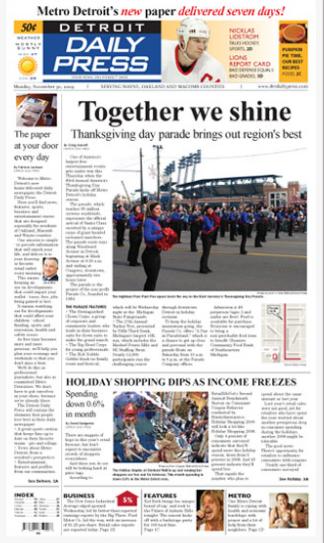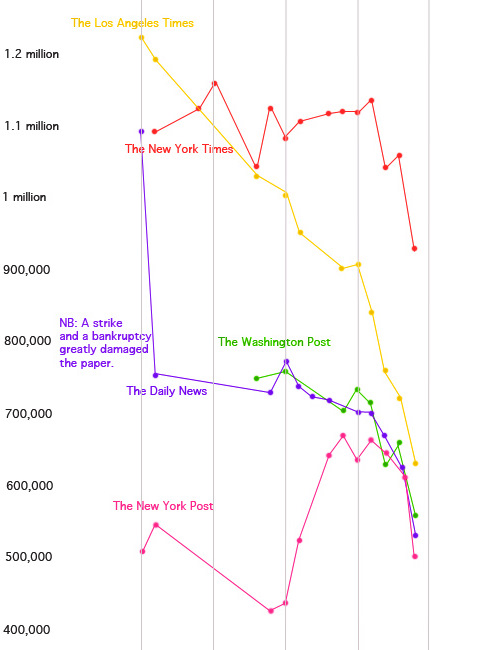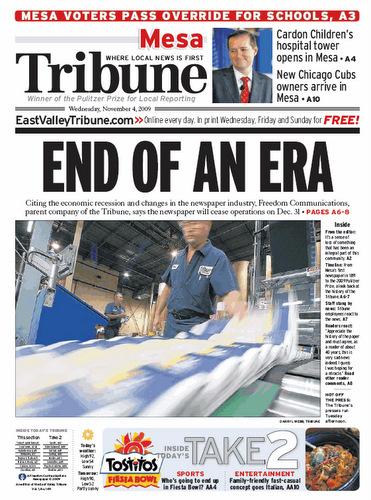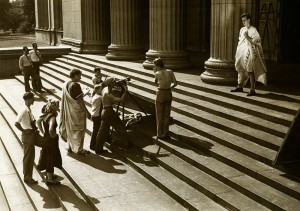It’s Thanksgiving Day in the US, so we present some thoughtful reading for consumption on a day of rest.
Study Examines Citizen Journalists’ Motivations
 There isn’t a lot of good news for traditional media organizations in a new study prepared by two college communication professors and funded by the McCormick Foundation. In preparing New Entrepreneurs: New Perspectives on News, Researchers interviewed approximately 50 female consumers and citizen journalists to learn how they see their role in the evolving news ecosystem and what motivations prompt them to participate. While most of the participants expressed respect for traditional media outlets, they also identified some serious shortcomings, including lack of connection with the local community, failure to innovate and hostility toward the grassroots work the citizens are doing. The 18-page report is quick reading.
There isn’t a lot of good news for traditional media organizations in a new study prepared by two college communication professors and funded by the McCormick Foundation. In preparing New Entrepreneurs: New Perspectives on News, Researchers interviewed approximately 50 female consumers and citizen journalists to learn how they see their role in the evolving news ecosystem and what motivations prompt them to participate. While most of the participants expressed respect for traditional media outlets, they also identified some serious shortcomings, including lack of connection with the local community, failure to innovate and hostility toward the grassroots work the citizens are doing. The 18-page report is quick reading.
One of the more striking conclusions is on the subject of objectivity. The citizen journalists expressed frustration at media reporting that equates objectivity with lack of involvement.
New media creators believe that they can be objective, but still be connected to their community and to the stories they report. They saw a very strong distinction between news and opinion and took great strides to ensure that they, their contributors and their readers understood the difference, but they did not see their “participatory perspective,” a more informed, connected perspective, as encroaching on objectivity.
Citizen journalists also believe that their connections and involvement in the local community gives them an advantage over the frequently shifting ranks of beat reporters.
Being a part of the community rather than detached from it also led to more thorough reporting in the opinion of some of the new media creators. They believed they had better access to sources and were better versed in the issues.
“Our local government was hilarious. A lot of times the paper can’t point that out because the paper is an authority figure, and an authority figure who points a finger and laughs is a bully. Whereas, I was just some person on the back porch.”
There are also indications that both consumers and content creators believe that traditional media overplay conflict in the quest to make stories more compelling. This polarizes participants and frustrates efforts to find common ground. Since citizen journalists have a vested stake in their communities, they believe that sensationalism works against the progress they are trying to achieve.
Several of the citizen journalists also said that local media organizations had reacted to their work with attitudes ranging from neglect to outright hostility.
The new media creators in particular felt that traditional media’s reaction to the changes was to attack the new media rather than embrace it. The passion and respect for journalism that was seen among all creators (and even consumers) may make some feel threatened by any change to the industry. But the new media creators are more likely to see the change as an evolution that can be accepted without threatening the basic standards of the profession.
This last point is the most troubling finding of the research. Read Clayton Christensen’s book, The Innovator’s Dilemma, to learn how market disruption almost always comes from below. The new entrants, which are frequently of inferior quality, are treated with disdain by the market leaders. However, as Christiansen points out, new kids on the block open access to much larger audiences and invariably improve with time. Meanwhile, market leaders tend to stake out the high-end and gradually become niched out of existence. The only way to avoid this fate is to embrace new competition, even if it causes considerable discomfort. Reinvention doesn’t come without pain.
Journalism is Changing, Not Disappearing
Doc Searles present a well-reasoned argument why journalism isn’t disappearing from the earth but simply following the path already blazed by business. Searles, who co-authored the seminal Web 2.O essay, “The Cluetrain Manifesto,” looks at the industry from a technologist’s perspective. Much as personal computers and open source software moved computing innovation from the center to the ends of the network, journalism is undergoing a similar metamorphosis. Journalism isn’t going away so much as being democratized.
present a well-reasoned argument why journalism isn’t disappearing from the earth but simply following the path already blazed by business. Searles, who co-authored the seminal Web 2.O essay, “The Cluetrain Manifesto,” looks at the industry from a technologist’s perspective. Much as personal computers and open source software moved computing innovation from the center to the ends of the network, journalism is undergoing a similar metamorphosis. Journalism isn’t going away so much as being democratized.
This transition is nothing new, Searles points out. Peter Drucker foresaw the end of the modern corporation in the late 1950s because “companies existed at the suffrance of the individuals who comprised them, even as it organized their work and put it to use.”
The current transition will move the nerve centers of journalism from monolithic organizations to networks of individuals. Specialists will be able to profit from their work, but they will compete on a truly open playing field. To use an analogy, in the preindustrial age anyone could set up shop and become a cooper, but only a small number of people were good enough or fast enough to make their living building barrels.
This is small consolation to the out-of-work journalists who have lost the enveloping arms of the corporate parent. Journalism’s traditionally high barrier to entry has kept out the vast majority of wannabes, but those barriers have now fallen away. Journalism in the future will be more competitive, but it will also be more innovative and rewarding because the rewards will accrue to the individual journalists rather than to their companies.
Common Sense on Creative Commons
If the concept of the Creative Commons license mystifies you, check out this essay by Joi Ito, CEO of the nonprofit Creative Commons organization. He draws an analogy to the open source license, which has revolutionized the quality and availability of software. If someone has tried to create a Google in the pre-Internet standards page, the effort would have cost billions of dollars and not worked very well. Google happened because standards were already in place and the founders didn’t have to navigate layers of approval and legal challenge. They built the basic technology for small money and evolved from there. The result is a service that has benefited the world rather than the handful of rich businesses. Had Google been created in the pre-open standards era, the fees the creators would have had to charge to make back their investment would have precluded its widespread adoption
The economics of Creative Commons and open source stands traditional business models on their head. In the past, copyright holders jealously guarded their franchise in the hopes of realizing a (usually small) license fee from its use. Under Creative Commons, the assumption is that good work will be passed around freely, usually with attribution to the author, thereby benefiting the Creator in other ways, such as through paid writing assignments, speaking engagements and publicity.
Ito’s case builds upon Doc Searles’ point that in a democratized economy, intelligence radiates outward the endpoints. The more people who adopt the work for their own use, the greater the benefit to everyone. In most cases, the creator also makes out.
There are exceptions, of course. A small number of large organizations stand to benefit when intellectual property is tightly controlled. However, openness creates opportunity for many others. Witness what has happened in the recording industry as the star-making machinery has ground to a halt and hundreds of thousands of bands have taken their case to MySpace. There may be fewer stars, but there are also more bands making a living by having control over their own destiny.
This idea even works for large entities. The success of Google Maps is largely due to the work of independent developers who have created remarkable mashups, while Unilever’s award-winning Dove Evolution TV ad has benefited from dozens of adaptations and parodies, each of which reinforces the value of the original work.
P.S. We just added a creative Commons license insignia to our right sidebar.
 After nearly losing its two daily newspapers a year ago,
After nearly losing its two daily newspapers a year ago,  Go to the basic
Go to the basic 







